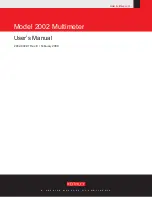
Operation
3-3
VSWR
VSWR (Voltage Standing Wave Ratio) is the ratio of the max-
imum and minimum voltages along a transmission path. It in-
dicates the degree of impedance mismatch. In a perfectly
matched system, the VSWR is 1, while open and shorted paths
have infinite VSWR values. Since VSWR is related to both the
return loss and reflection coefficient, VSWR figures indicate
the degree of signal loss and reflection. The lower the VSWR
figure, the less signal attenuation that occurs along the trans-
mission path.
Path isolation resistance
The path isolation resistance is the equivalent resistance be-
tween two given connecting points on the card and is of impor-
tance primarily for DC and low-frequency AC signals switched
by the card. The effects of this characteristic depend on the par-
ticular isolation specification. Center-to-shield isolation resis-
tance, for example, may cause loading problems with signals
having high source resistance. Channel-to-channel isolation re-
sistance may result in leakage currents generated in one chan-
nel caused by a voltage source connected to another channel.
3.5.2 Cable characteristics
Characteristic impedance (Zo)
Characteristic impedance is the value of cable impedance ob-
tained by an RF measurement at either end. For example, a
cable with a 50
Ω
characteristic impedance is equivalent to a
50
Ω
resistor with sufficient length to connect two compo-
nents. (The characteristic impedance of a cable depends on
the relative diameters of the inner and outer conductors, as
well as on the dielectric constant of the insulating material.)
Since the Model 7017 is designed to work with 50
Ω
cables,
you must use 50
Ω
cables to assure proper impedance match-
ing. (RG223/U cable is recommended.) Mismatching any-
where along the transmission path will increase VSWR and
signal reflections, decrease return loss, and consequently re-
sult in signal attenuation.
Cable attenuation
Cable attenuation is analogous to insertion loss of the card it-
self in that it defines the degree of attenuation of the signal as
it passes through the cable. Cable attenuation factors are gen-
erally given in dB per 100 ft. and increase with rising fre-
quency. For example, the recommended RG223/U cable has
an attenuation factor of 8.8dB/100 ft. @ 400MHz.
Cable termination
Proper cable termination is imperative to ensure maximum
signal transfer and to minimize VSWR and signal reflec-
tions. In the case of Model 7017 operation, both source and
load impedances should be as close to 50
Ω
as possible to
assure optimum matching and maximum power transfer.
For example, if a 50
Ω
cable is terminated with 100
Ω
, the
reflection coefficient is 0.33, the VSWR increases to 2, and
the return loss is reduced to less than 10dB.
Distributed capacitance
The distributed capacitance of the cable may be a factor, but
generally only for pulse type signals where rise times are a
consideration. The recommended RG223/U cable, for exam-
ple, has a nominal distributed capacitance of 30.8pF/ft.
Cable connectors
Cable connectors are necessary to conveniently make signal
connections to various points in a switching system. While
SMA connector designs are optimized for best performance,
some small impedance mismatch at connecting points is vir-
tually inevitable. For that reason, it is considered good prac-
tice to minimize the number of connectors used in a
transmission path, especially at higher frequencies.
3.6
Applications
The Model 7017 is designed primarily for RF switching ap-
plications at frequencies up to 800MHz. The following para-
graphs discuss typical RF applications for the Model 7017,
including multiplexer expansion, filter testing, and tape head
production testing.
3.6.1 Multiplexer expansion
Basic “T” configuration
The simplest way to connect two Model 7017 multiplexers
together for expansion is to use the classic “T” configuration
shown in Figure 3-1. Note that this configuration results in a
1-of-8 multiplexer. Although this configuration is useful in
many applications, the ideal 50
Ω
characteristic impedance
will not be maintained. Consequently, VSWR will increase,
affecting card insertion loss particularly at higher frequen-
cies. Considerable transmission path reflections will also oc-
cur, which is an important consideration when switching
pulse signals.
Summary of Contents for 7017
Page 38: ......
Page 39: ......
Page 40: ......
Page 43: ...Keithley Instruments Inc 28775 Aurora Road Cleveland Ohio 44139 Printed in the U S A...
















































